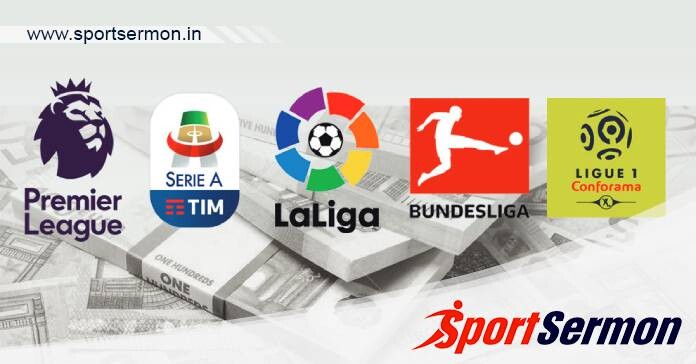Financial Parity Across Europe’s Top Five Leagues: The world of football is not only a battleground of skills and tactics but also a realm of financial prowess. This article delves into the intricate web of financial parity that exists among the top five European leagues, namely the English Premier League, La Liga, Serie A, Bundesliga, and Ligue 1. As football’s commercial landscape evolves, understanding the nuances of financial equality becomes crucial in assessing the competitive equilibrium across these elite competitions.
One of the biggest talking points in European football is the varying levels of parity between the major leagues in England, Spain, Germany, Italy and France. The competitive balance between clubs at the top and bottom of each league differs significantly depending on financial distributions.
In this article, we analyze how competitive balance in Europe’s top five leagues is impacted by factors like television rights distributions, Champions League revenue, ownership models, club debt levels and wage bill disparities.
The financial landscape of the top five European leagues is a tapestry woven with intricate threads of revenue streams, broadcasting deals, sponsorship agreements, and matchday revenues. While each league boasts its unique revenue generators, examining their financial dynamics offers a fascinating glimpse into the intricate balance they strive to maintain.
Financial Fair Play: Regulating the Playing Field

UEFA’s Financial Fair Play regulations play a pivotal role in maintaining financial equilibrium. These regulations aim to prevent clubs from spending beyond their means, fostering a sustainable financial ecosystem that ensures long-term competitiveness. While some critics argue that Financial Fair Play may hinder smaller clubs’ ambitions, its overarching goal is to create a level playing field that ensures the sport’s overall health.
Premier League TV Rights Dominance
The richest league in Europe by far is England’s Premier League, which earns €3.6 billion annually from domestic and international TV rights deals. These TV earnings dwarf all other leagues.
The Premier League’s centralized TV rights system also ensures relatively equal distributions between all 20 clubs. This gives even bottom sides Premier League TV income that exceeds most other European teams.
While Premier League TV money has helped mid-table teams compete, the very top clubs still splurge on transfers and wages. Huge TV earnings make the Premier League highly attractive to investors and oligarchs keen to buy elite clubs and spend big.
La Liga’s Top-Heavy Model
Spain’s La Liga earns around €1.9 billion annually from TV rights, but its distributions are far more uneven. Barcelona and Real Madrid take over 50% of earnings, giving them huge financial advantage.
This top-heavy system makes the La Liga title race a virtual two-horse race every season. Outside the top two, earnings drop sharply, making it hard for other clubs to build squads to compete consistently.
Bundesliga Ownership Regulations
Germany’s Bundesliga has the most balanced clubs thanks to its strict ownership rules. Regulations like the 50+1 rule limit outside investor ownership of clubs. Member associations retain voting rights.
The Bundesliga’s balanced distributions and ownership model allows clubs like Borussia Dortmund and RB Leipzig to regularly challenge for titles. However, Bayern’s consistency dominates over a prolonged period.
Serie A’s Stadium Woes
Italy’s Serie A was once Europe’s top league financially but has fallen behind due to aging stadium infrastructure. Matchday revenues are far lower than England or Germany.
Huge debts at clubs like Juventus, Inter and AC Milan also curb investment in players. However, Serie A has become more competitive recently as challengers like Napoli and Atalanta emerge despite financial limitations.
Ligue 1 Disparity and PSG Domination
France’s Ligue 1 suffers from the widest financial gulf. Between its top club Paris Saint-Germain and the rest of the league.
PSG’s Qatar-backed spending dwarfs all rivals, illustrated by massive transfer deals and wages. Their budget exceeds €600m, four times larger than next biggest club Lyon.
This huge imbalance, combined with poor stadiums and little foreign investment, makes Ligue 1 the least competitive among Europe’s top leagues. PSG faces no serious title challengers.
Conclusion
Europe’s top leagues face vastly different challenges around competitive balance that influence sporting outcomes. The Premier League, Bundesliga and Serie A demonstrate relative parity. La Liga and Ligue 1 remain far more unequal as elite clubs dominate.
Getting the right balance between rewarding success and allowing others to compete will continue posing challenges. The quest for financial parity among Europe’s top five leagues is an ongoing journey. Marked by intricate negotiations, evolving revenue models, and strategic alliances. As the beautiful game continues to captivate audiences worldwide, maintaining a delicate equilibrium between financial prowess and sporting excellence becomes a collective endeavor—one that ensures that the pulse of football continues to beat with passion, competition, and captivating drama across all corners of the continent. But the variety of ownership models and revenue distributions make comparing parity across these leagues endlessly fascinating. The perfect balance likely remains elusive.

